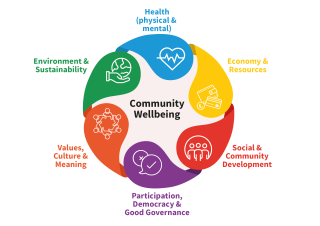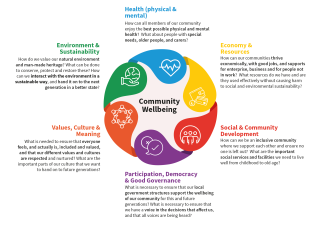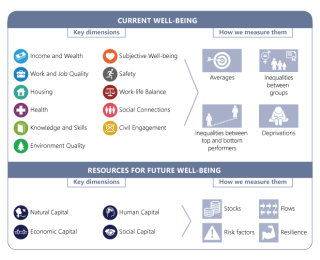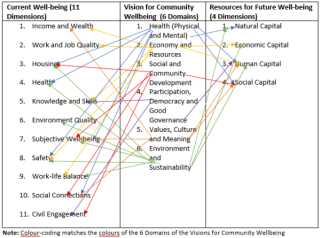Participation for Wellbeing

When the Public Participation Networks were established in 2014, one of the areas they were tasked with was “going through a process to set out what they consider necessary to promote well-being for present and future generations.” to develop a ‘Wellbeing Statement’. The purpose of this ‘Wellbeing Statement was to “act as a guiding vision statement for everything done by the group that drew up the statement e.g. choosing representatives, taking positions on issues, developing activities of any kind etc.”
Further, the PPN User Guide explained that “A wellbeing statement looks at what is required for the wellbeing of individuals and communities, now and for the generations to come.” and it involves the interplay of social, economic and environmental factors which facilitate living well in a particular community both now and long into the future.
In September 2016, a reference group was established to develop a toolkit of supports for PPNs to develop their own Visions for Community Wellbeing. Four PPNs were involved in piloting these supports: Cork City PPN, Longford PPN, Roscommon PPN, and Wicklow PPN and developing the final Toolkit. Since then, Social Justice Ireland have been engaged by the Department of Rural and Community Development to manage the roll-out of this toolkit of supports across the PPN networks and to support their initial consultation meetings. An independent facilitator, engaged throughout the development of the development of the toolkit itself, also supports this work.
Visions for Community Wellbeing
The Vision for Community Wellbeing were developed across six interconnected domains. These are Health (Physical and Mental); Economy and Resources; Social and Community Development; Participation, Democracy and Good Governance; Values, Culture and Meaning; and Environment and Sustainability (Fig. 1).
Fig.1: 6 Domains for a Vision for Community Wellbeing

The process begins with an asset-mapping exercise where participants are divided into groups and provided with maps of the local area / Municipal District. They are then asked to identify what is valued in their community and what they would like to preserve into the future. Once this exercise is completed, the groups are asked to consider the six wellbeing domains and complete the sentence “For our community to be the best that it can be, we want to see…” in the context of each.
Once the consultation outputs are then made available online for a further period to ensure as wide a consultation as possible.
When all inputs have been received, the Vision document is drafted. The Visions for Community Wellbeing take a high-level approach to the inputs received, from individual issues or wants / needs to more general vision language.
A review of 13 published Visions for Community Wellbeing (Carlow, Cavan, Clare, Cork City, Fingal, Galway City, Longford, Monaghan, Roscommon, Tipperary, Westmeath, Wexford, and Wicklow) allows us to identify some common themes:
In addition to the physical infrastructure that supports good mental and physical health, is the recognition of the need for understanding for people experiencing mental health issues and for a community-based approach to supports for vulnerable people generally.
Cork City, Fingal, Longford, Monaghan, Tipperary and Wexford PPNs also make specific reference to the importance of the built environment and infrastructure generally to the health of the individual.
Sustainability and local jobs, decent training and the support of society / citizens are key themes that emerge under this domain throughout the 13 PPNs. A local economy that supported entrepreneurs and indigenous enterprises also featured for many.
This domain spanned a very broad range of areas for the communities in which the 13 PPNs are situated. Cultural diversity and infrastructure featured in the Visions of Carlow, Clare, Cork City, Longford, Monaghan, Roscommon, Tipperary, Westmeath, Wexford and Wicklow PPNs as important to Social and Community Development.
The importance of acknowledging and valuing contributions from community members was also referenced in several Visions.
Deliberative democracy – where communities had a say in the decisions that affect them – was a theme across all 13 Visions. Accountability and transparency across governance structures with an openness to engage featured in many Visions, as did the importance of capacity building opportunities to allow people from within communities to be proactive.
The diversity of the counties’ citizenry and the support for expressions of cultural identity and inclusion was very evident across all the Visions of all 13 PPNs. The protection of built heritage sites was also included, and spaces to hold cultural events were included in most.
Sustainability, biodiversity and the natural environment featured in all 13 Visions.
Within this context, some PPNs also included specific aspects of environmental protection. Clare PPN also included small holding and farm to fork production and use; Cork City PPN promoted safety and the development of sites as cultural and recreational amenities; affordability of amenities featured for Fingal PPN; and waste management was a feature for Monaghan PPN.
Synergies with OECD Framework
The OECD Framework consists of 11 Key Dimensions of Current Wellbeing, and 4 Key Dimensions in the Resources for Future Well-being (Fig. 2).
Fig 2.: OECD Wellbeing Framework

Each of these dimensions were indicated across the six domains of the Visions for Community Wellbeing for the 13 PPNs reviewed (Fig. 3).
Fig. 3: OECD Wellbeing Framework, Government of Ireland Proposed Framework and PPN Visions for Community Wellbeing

Conclusion
The extensive consultative process undertaken by the PPNs was a key factor in developing Visions for Community Wellbeing that are robust and reflective of the communities in which the PPNs are situated.
A review of the 13 Visions for Community Wellbeing developed by the PPNs indicates that areas of particular importance to these communities are: Sustainability; Inclusion and Diversity; Local Economies that support society; Civic Engagement; and Social Connectedness.
There is significant cross-over between domains, for example the Health (Physical and Mental) went far beyond the need for decent healthcare, to the importance of the environment, infrastructure and social connection, and this is the case for all domains (as can be seen in Fig. 3).
In building a National Wellbeing Framework, we must be mindful of this cross-over and how one dimension can be used to provide metrics that span a range of policy areas.